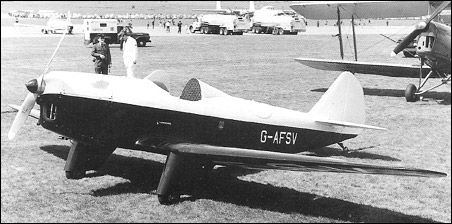|
| A low-wing, fixed undercarriage wooden light aircraft, the DW.1 was built in small numbers. It won the 1939 Lympne-Folkestone air race. For many, this type epitomizes the
golden era of pre-World War II British light aircraft design. As a consequence examples survive today and others are being newly built from plans by enthusiasts.
| CREW | 1 |
| PASSENGERS | 1 |
| ENGINE | 1 x 30hp Carden Ford piston engine |
| DIMENSIONS |
| Wingspan | 7.30 m | 24 ft 11 in |
| Length | 5.49 m | 18 ft 0 in |
| Height | 1.30 m | 4 ft 3 in |
| PERFORMANCE |
| Max. speed | 180 km/h | 112 mph |
| Range | 160 km | 99 miles |
| Peter H, e-mail, 21.03.2015 19:01 According to the 1938 write-up in "Flight" and the company's advert, the range was 500 miles not 99 as stated above reply | | adolf jaeger, 26.12.2010 00:21 Idiotic comment, Hancocks. Light and low-powered sportsplanes were built in Germany as well at the same time period, just us England built their own killing machines. reply | | John Hancocks, e-mail, 25.03.2010 06:31 I look at the performance figures and my blood runs cold. While the gentlemen amateurs of the UK fussed around with primitive, low tech. items such as the Chilton and the Comper Swift, in Germany technocrats were wasting no time on such playschool antics, they concentrated on high performance killing machines soon to be unleashed on a World largely unprepared. reply | | john mcdonald, e-mail, 13.01.2010 12:21 Do you require more Chilton photographs?
Juhn McDpnald, Chilton DW1 (1938) GAFGI reply |
|
Do you have any comments?
|
| 
All the World's Rotorcraft |






